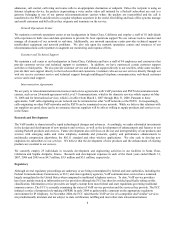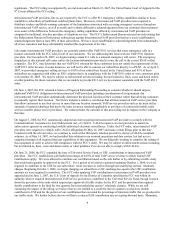8x8 2007 Annual Report Download - page 20
Download and view the complete annual report
Please find page 20 of the 2007 8x8 annual report below. You can navigate through the pages in the report by either clicking on the pages listed below, or by using the keyword search tool below to find specific information within the annual report.We may be subject to liabilities for past sales and additional taxes, surcharges and fees.
Excluding California sales and use tax, federal Universal Service Fund or USF and E911 state and local fees, we do not collect
state and federal telecommunications taxes or other telecommunications surcharges with respect to our Packet8 service in
accordance with current industry practice. Based upon a new ruling published by the Internal Revenue Service, or IRS, we
ceased collecting Federal Excise Tax, or FET, on June 1, 2006. We do not collect Value Added Tax, or VAT, for services that
we provide to customers in European Union, or EU, member countries. Future expansion of our Packet8 service, along with
other aspects of our evolving business, may result in additional sales and other tax obligations. One or more states or foreign
countries may seek to impose sales or other tax collection obligations on out-of-jurisdiction companies that provide telephone
service. A successful assertion by one or more states or foreign countries that we should collect sales or other taxes on the sale
of merchandise or services could result in substantial tax liabilities for past sales, decrease our ability to compete with
traditional telephone companies, and could have a material adverse effect on our business, financial condition or operating
results.
We have received inquiries or demands from numerous states and municipal taxing and 911 agencies seeking payment of taxes
that are applied to or collected from the customers of providers of traditional public switched telephone network services. We
have consistently maintained that these taxes do not apply to our service for a variety of reasons depending on the statute or
rule that establishes such obligations. In September 2006, our largest third party network service provider vendor began
passing through E911 taxes to us. On October 1, 2006, we began collecting certain state and local E911 charges from our
customers for these amounts. The amounts collected from our customers are paid to the third party network service provider.
We have not collected or accrued liabilities for E911 taxes prior to October 1, 2006, and it is possible that substantial claims for
back taxes may be asserted against us, which could adversely affect our business financial condition or operating results.
One or more states or foreign countries may seek to impose sales, use or other tax collection obligations on us. We have
received inquiries or demands from numerous state authorities and are currently under audit by one state. A successful
assertion by one or more states or foreign countries that we should collect sales, use or other taxes on the sale of customer
premise equipment or services could result in substantial tax liabilities for past sales, decrease our ability to compete with
traditional telephone companies, and could have a material adverse effect on our business, financial condition or operating
results. We have recorded an expense of $841,000 and $531,000 for years ended March 31, 2007 and 2006, respectively, as our
estimate of the increase in probable tax exposure for such assessments. We believe that our exposure for assessments is
$1,570,000 as of March 31, 2007, which is recorded as an other accrued liability in our condensed consolidated balance sheets.
Our emergency and E911 calling services are different from those offered by traditional wireline telephone companies
and may expose us to significant liability. There may be risks associated with limitations associated with E911
emergency dialing with the Packet8 service.
Both our emergency calling service and our E911 calling service are different, in significant respects, from the emergency
calling services offered by traditional wireline telephone companies. In each case, the differences may cause significant delays,
or even failures, in callers’ receipt of the emergency assistance they need.
Traditional wireline telephone companies route emergency calls over a dedicated infrastructure directly to an emergency
services dispatcher at the Public Safety Answering Point, or PSAP, in the caller’s area. Generally, the dispatcher automatically
receives the caller’s phone number and actual location information. While the E911 service we have deployed in the United
States is designed to route calls in a fashion similar to traditional wireline services, our E911 capabilities are not yet available
from all locations. In addition, the only location information that our E911 service can transmit to a dispatcher at a PSAP is the
information that our customers have registered with us. A customer’s registered location may be different from the customer’s
actual location at the time of the call because customers can use their Packet8 equipment to make calls almost anywhere a
broadband connection is available.
We are currently deploying E911 service that is similar to the emergency calling services provided to customers of traditional
wireline telephone companies in the same area. For those customers located in an E911 area, emergency calls are routed,
subject to the limitations discussed below, directly to an emergency services dispatcher at the PSAP in the area of the
customer’s registered location. The dispatcher will have automatic access to the customer’s telephone number and registered
location information. If a customer moves their Packet8 service to a new location, the customer’s registered location
information must be updated and verified. Until that takes place, the customer will have to verbally advise the emergency
dispatcher of his or her actual location at the time of an emergency 911 call.
The emergency calls of customers located in areas where we are currently unable to provide E911 service as described above
are supported by a national call center that is run by a third-party provider and operates 24 hours per day, seven days a week.
18
























